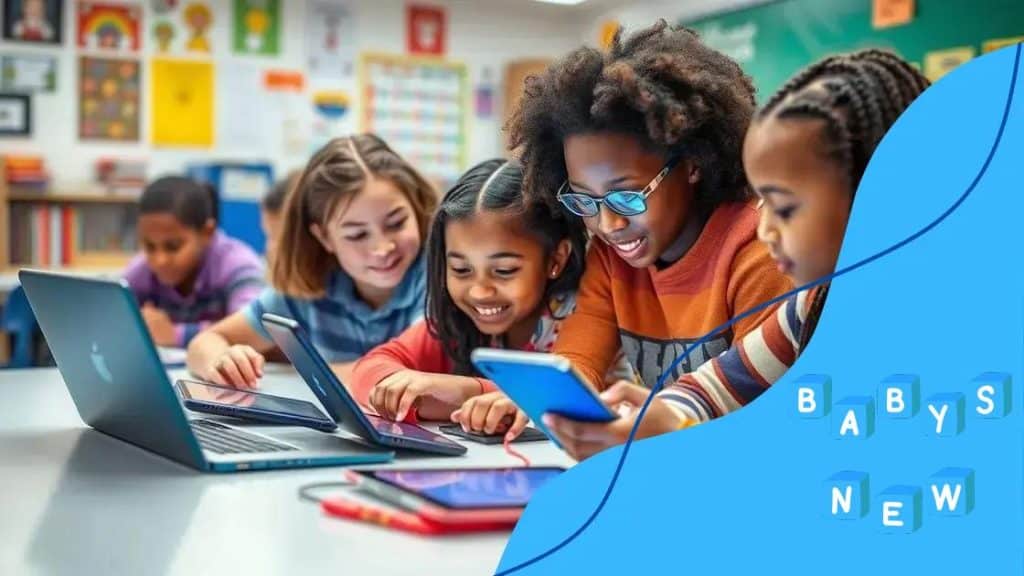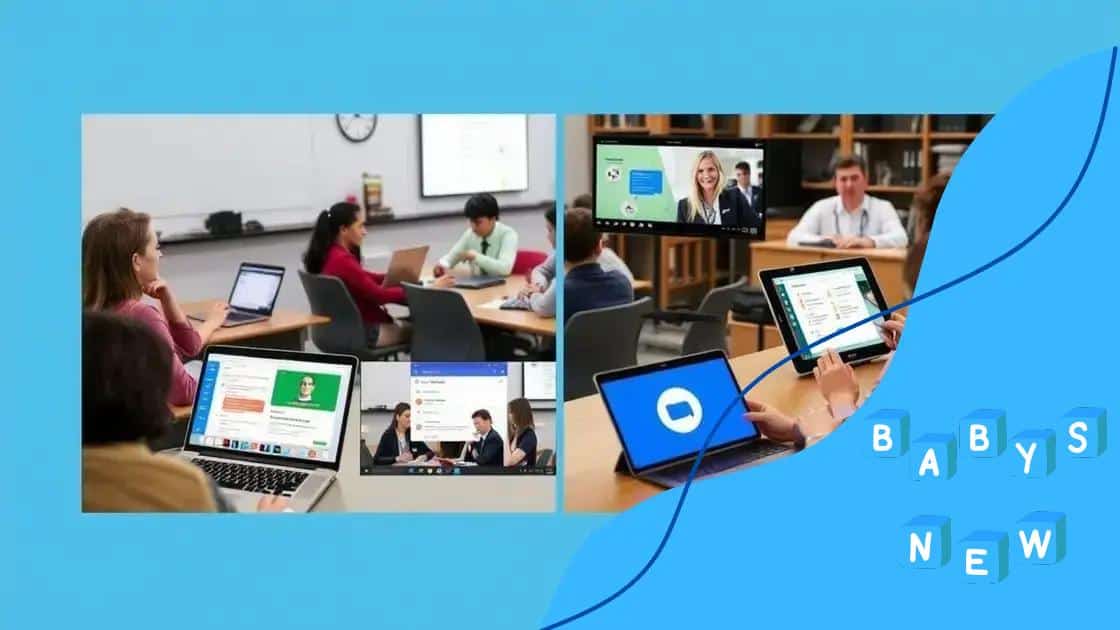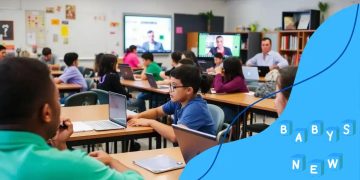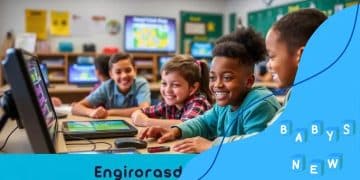Collaborative digital classrooms: enhancing education together

Advertisement
Collaborative digital classrooms utilize technology to enhance teamwork and engagement, enabling students and teachers to interact effectively and improve learning outcomes through tools like Google Classroom and virtual collaboration platforms.
In today’s educational landscape, collaborative digital classrooms are becoming increasingly popular. They offer students a chance to engage, share ideas, and learn collaboratively, making education more interactive. Have you wondered how these classrooms can change the way we learn?
Understanding collaborative digital classrooms
Understanding collaborative digital classrooms is essential in today’s tech-driven education environment. These classrooms use technology to foster teamwork and engagement among students. By integrating various digital tools, teachers can create a more dynamic learning experience.
Defining Collaborative Digital Classrooms
A collaborative digital classroom utilizes online platforms to allow students to work together, share ideas, and engage with course materials. These environments promote communication and confidence in a safe setting. They prepare students for real-world interactions and teamwork.
Advertisement
Key Features of Collaborative Digital Classrooms
- Real-time communication tools, such as chat and video conferencing.
- Shared digital resources and collaborative projects.
- Interactive learning experiences that engage diverse learning styles.
In these classrooms, students often take charge of their learning. They can explore subjects in depth and collaborate on projects that showcase their creativity. Technology plays a crucial role in making these experiences possible. Schools utilize platforms like Google Classroom, Microsoft Teams, and Zoom to connect students.
Another important aspect is flexibility. Students can learn at their own pace and revisit materials whenever they need. This self-directed learning approach encourages more personal responsibility and critical thinking. Moreover, teachers can easily track student progress and provide tailored support to meet individual needs.
Benefits of Collaborative Digital Classrooms
Implementing collaborative digital classrooms offers numerous advantages:
Advertisement
- Increased engagement and motivation among students.
- Improved communication skills as they work with peers.
- Access to a broader range of resources and information.
As these classrooms evolve, they continue to shape the future of education. They allow for a unique blend of traditional teaching and innovative practices, which can lead to better outcomes for all students. Embracing this approach fosters an environment where everyone can thrive and succeed together.
Key benefits for students and teachers
Exploring the key benefits of collaborative digital classrooms reveals how they enhance learning for both students and teachers. These benefits go beyond traditional education methods, creating engaging environments conducive to skill development.
For Students
One major advantage for students is the enhanced engagement they experience in these classroom settings. By working collaboratively, they feel more connected to their peers and the learning material. This connection encourages active participation, which is crucial for understanding concepts deeply.
Benefits Include:
- Improved Communication: Students learn to express their ideas clearly while listening to others.
- Critical Thinking Skills: Working together on projects fosters problem-solving abilities.
- Increased Motivation: Collaborative tasks can be more enjoyable, making students eager to learn.
Another significant benefit is increased access to resources. Students can use various online tools to gather information and collaborate on assignments. This access allows them to explore topics more thoroughly and creatively. Furthermore, the comfortable atmosphere in a digital classroom nurtures effective learning habits and boosts student confidence.
For Teachers
Teachers also gain numerous benefits from implementing collaborative digital classrooms. They can easily track student progress through digital tools and adjust their teaching methods accordingly. This personalized approach helps ensure that all students understand the material.
Benefits Include:
- Enhanced Feedback: Teachers can provide immediate feedback, which is essential for student growth.
- Resource Sharing: Collaboration among educators leads to better lesson plans and teaching strategies.
- Professional Development: Teachers engage in ongoing learning through shared experiences.
As both students and teachers work together in a collaborative digital classroom, they create a community focused on collective growth. This environment supports diverse learning styles, promoting a more inclusive education. Overall, the synergy between students and teachers fosters a positive educational experience that prepares everyone for future challenges.
Tools and technologies for effective collaboration

Using the right tools and technologies in collaborative digital classrooms plays a vital role in enhancing the learning experience. These resources help facilitate communication and encourage teamwork among students.
Essential Tools
Several tools are specifically designed to support collaboration in educational settings. These tools allow students to interact seamlessly, fostering an engaging environment. Popular options include:
- Google Classroom: This platform allows teachers to create and manage classes effectively while providing a space for assignments and discussions.
- Microsoft Teams: Teams offer a robust platform for video conferencing, file sharing, and real-time collaboration on projects.
- Zoom: Ideal for virtual meetings, Zoom connects students and teachers for lessons and discussions from anywhere.
Another crucial technology is cloud storage. Services like Google Drive or Dropbox allow students to store and share their work easily. This makes it simple to collaborate on group assignments without worrying about losing files or version control issues.
Enhanced Collaboration Features
Many of these tools come equipped with features that enhance collaboration. Real-time editing and messaging functions enable students to work together on documents and presentations simultaneously. They can see each other’s changes instantly, creating a dynamic workflow.
Supporting Different Learning Styles
In a collaborative digital classroom, various technologies can help support different learning styles. For instance, visual learners benefit from platforms that incorporate multimedia content, while auditory learners may excel with video discussions. Providing diverse tools ensures every student can engage effectively.
Additionally, classrooms can leverage project management tools like Trello or Asana. These applications help organize group projects, assign tasks, and track progress. By promoting accountability, they teach valuable skills for future collaboration in both academic and professional environments.
Ultimately, integrating effective tools and technologies into collaborative digital classrooms not only enhances student interaction but also prepares them for a tech-driven world. These resources empower students to take charge of their learning and build essential skills that are crucial for their futures.
Strategies to implement collaborative digital classrooms
Implementing collaborative digital classrooms requires careful planning and effective strategies. These approaches help create an engaging and productive learning environment for students and teachers alike.
Establish Clear Objectives
One of the first steps to successful implementation is to establish clear learning objectives. Determine what skills and knowledge you want students to gain from their collaborative experiences. This clarity will guide decision-making and help choose the right tools.
Choose the Right Technology
Select technology that is user-friendly and suits the needs of your classroom. Consider platforms like Google Classroom or Microsoft Teams that support collaboration and make communication straightforward. Ensuring accessibility for all students is vital.
Foster a Collaborative Culture
Creating a culture of collaboration starts with building relationships. Encourage students to communicate openly and respect each other’s ideas. Activities like team-building exercises can help strengthen these connections.
Set Up Collaborative Projects
Implement group projects that require teamwork. Assign roles to each student to ensure every member contributes. This structure not only promotes collaboration but also teaches responsibility and accountability.
- Use self-paced learning tools to let students explore topics of interest.
- Incorporate peer review sessions to encourage feedback among students.
- Integrate digital presentations where students can share their findings with the class.
Additionally, consider incorporating internal evaluations as part of group projects. This will keep students engaged and reflective about their collaboration process. It also teaches them to give and receive constructive criticism.
Provide Ongoing Support
Offer continuous support and resources to both students and teachers throughout the implementation process. Offer training sessions for teachers to familiarize them with digital tools. Encourage students to ask questions and seek help when needed. Providing guidance fosters a positive learning atmosphere.
Finally, regularly assess the effectiveness of your strategies. Gather feedback from students about their experiences. Adjust your approach based on their insights to enhance future collaborations.
Future trends in digital classroom collaboration
As we look to the future, several exciting trends in digital classroom collaboration are shaping how students and teachers interact. These trends leverage technology to create more engaging and effective learning experiences.
Increased Use of Artificial Intelligence
One significant trend is the integration of artificial intelligence (AI) in educational tools. AI can personalize learning by adapting content to each student’s pace and style. This technology helps students grasp concepts more efficiently and allows teachers to focus on supporting individual learning needs.
Virtual Reality and Augmented Reality
Another emerging trend is the use of virtual reality (VR) and augmented reality (AR) in classrooms. These technologies provide immersive experiences that can make learning more engaging. For example, students can explore historical sites or conduct virtual science experiments right from their classrooms.
Enhanced Collaboration Tools
As technology evolves, so do the tools designed for collaboration. Future digital classrooms will see tools that not only facilitate communication but also offer more interactive features. Real-time online whiteboards and project management software will enhance teamwork among students.
Focus on Social-Emotional Learning
Future digital classrooms will also put a stronger emphasis on social-emotional learning. Collaborative projects will not only focus on academic skills but will also help students develop crucial interpersonal skills. By working together, they learn communication, empathy, and conflict resolution.
Global Collaboration Opportunities
Digital classrooms will continue to break geographical barriers, allowing students to collaborate globally. They can work with peers from different parts of the world on shared projects, gaining diverse perspectives. This global interaction will enrich their learning experience and prepare them for a multicultural world.
As we adapt to these future trends, the landscape of education will transform. By harnessing the power of technology and fostering collaboration, digital classrooms will evolve into dynamic spaces where students thrive together.
In summary, collaborative digital classrooms are revolutionizing the way education is delivered. By integrating technology and fostering teamwork, these classrooms offer numerous benefits for both students and teachers. Future trends such as AI integration, virtual reality experiences, and an emphasis on social-emotional learning will further enhance collaboration in education. As we embrace these changes, it’s crucial to ensure that all students can adapt and thrive in this new learning environment.
FAQ – Frequently Asked Questions about Collaborative Digital Classrooms
What are collaborative digital classrooms?
Collaborative digital classrooms are learning environments that use technology to facilitate teamwork and communication among students.
How do these classrooms enhance student engagement?
They promote active participation by allowing students to work together on projects, share ideas, and interact with learning materials.
What technologies are essential for effective collaboration?
Key technologies include platforms like Google Classroom, Microsoft Teams, and tools for virtual and augmented reality.
What benefits do teachers gain from collaborative digital classrooms?
Teachers can easily track student progress, provide personalized support, and facilitate an inclusive learning environment.





